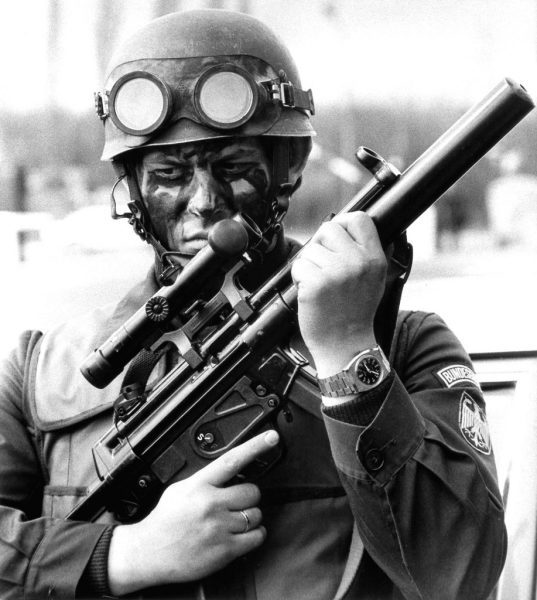The MP5 originated as Heckler and Koch’s Project 65. It was created as a roller delayed blowback evolutionary
The MP5 originated as Heckler and Koch’s Project 65. It was created as a roller delayed blowback evolutionary descendant of the revolutionary MG42, which featured the first mass produced roller lock mechanisms and stamped metal firearms technology. In addition to its smooth-shooting roller-delayed action, the MP5 also featured a non-reciprocating charging handle, a unique rear diopter drum sight (that needs a special tool for adjustment) and a fluted chamber that facilitated extraction. It wasn’t long before the MP5 earned a following. There were a number of successful submachineguns already on the market, with the Uzi being the most ubiquitous and consistently the MP5’s greatest competitor until the mid-1990s. By the late 1990s new SMG/PDW technology, combined in the US with a move toward ever-shorter M16/M4 configurations, fostered a decline in conventional SMG use. However, by that time the MP5 was already an icon.
The HK MP 5, which supports semi-automatic and selective fully automatic fire, won its first customers by 1966 and it caught on quickly with military, police, and security services. However, the Uzi largely overshadowed the MP5 until 1980. The world changed quickly in the latter half of the 1970s. Social, economic, political, and even religious paradigms shifted noticeably. The US recovered from Vietnam and shifted to a conventional warfighting focus marked successively by strategies of Active Defense and Air-Land Battle, both of which evolved from studies of the Six Day War and the Yom Kippur War. Meanwhile, the Soviet Union immersed itself in the Afghan quagmire, while increasing spending to try and outmatch a revitalized NATO. Terrorism as we know it today also bloomed in the 1970s.
The Iranian Embassy Siege in London brought this terrorism home not only to the UK, but to Europe and the West in 1980. The British response to the Siege, Operation Nimrod, and specifically a few famous photographs of the SAS storming the embassy armed with the then lesser-known MP5, vaulted the system into the limelight. A few MP5s in the hands of very skilled SAS operators arguably made the MP5 an instant success.
Following Operation Nimrod, everybody in the West wanted the MP5. Virtually every special operations unit adopted it in one form or another. In the United States, the MP5 became a staple of units such as the Navy Seals, MEUSOC, and Delta Force, in addition to most police SWAT teams. Licensee factories in places like Mexico, France, Great Britain, and even Iran produced the MP5.
Special needs and requirements led HK to develop variants such as the integrally suppressed MP5SD, and the MP5K (an early commitment to the PDW concept, and a positive influence on their later development). Additionally, HK reacted positively to special requirements from end users, resulting in such variants as the MP5/40 and the MP5N, designed specifically at the behest of the US Navy.
In addition, the HK MP 5 yielded a long list of variants, including the MP5A1 (a compact, stockless variant), the MP5A4 (which has a fixed stock), the MP5SF (a semi-auto variant intended for law enforcement agencies), MP5SD and MP5K, among many others which have been widely adopted and used.
The MP5 played a role in combat operations around the world from the early 1980s onward, and it earned a stellar reputation for accuracy and reliability. Its mostly positive geometry and ergonomics earned it accolades such as ‘the gun that shoots itself’. The MP5 is not only still in active service, but it is still in active production, although production in Germany has been greatly curtailed in favor of a newer generation of PDWs such as the MP7. In the United States in particular, a lack of spare parts and overall support for the MP5, coupled with a rise in the popularity of the M4 platform, led to a decline in MP5 use by military units and law enforcement agencies.
Yet the MP5 has plenty of life left in it. Its bombproof roller delayed action and excellent accuracy provide arguably the best 9mm NATO subgun platform still in active service. Despite its lengthy service history, the HK MP 5 is one of the most highly respected subguns in history and has been used by more than 50 countries around the world, spawning countless variants. The MP5 is also a sweetheart of the movie industry, having claimed the starring role in various military themed movies, and in such box office hits as such Die Hard and The Matrix. The MP5 was already featured prominently in popular video games including Call of Duty and Battlefield, among many others.
In the civilian community the MP5 and its variants, whether semi-auto or full auto, have always had a solid fan base. Transferable full auto MP5s on the US civilian market regularly trade for north of $25,000.00. While not an economical gun for all, it is a ‘bucket list’ gun for many. The market for licensed reproductions and clones remains strong, although even in its semi-automatic configuration it is an upper tier firearm with a considerable price tag.
If you have a chance, take the time to beg, borrow, rent, or buy an MP5 and try it for yourself. Beware, however: there are so many experienced shooters out there, who know how well the MP5 performs, that you will not be able to get away with saying “It’s the gun’s fault!” if you do not shoot it well.
